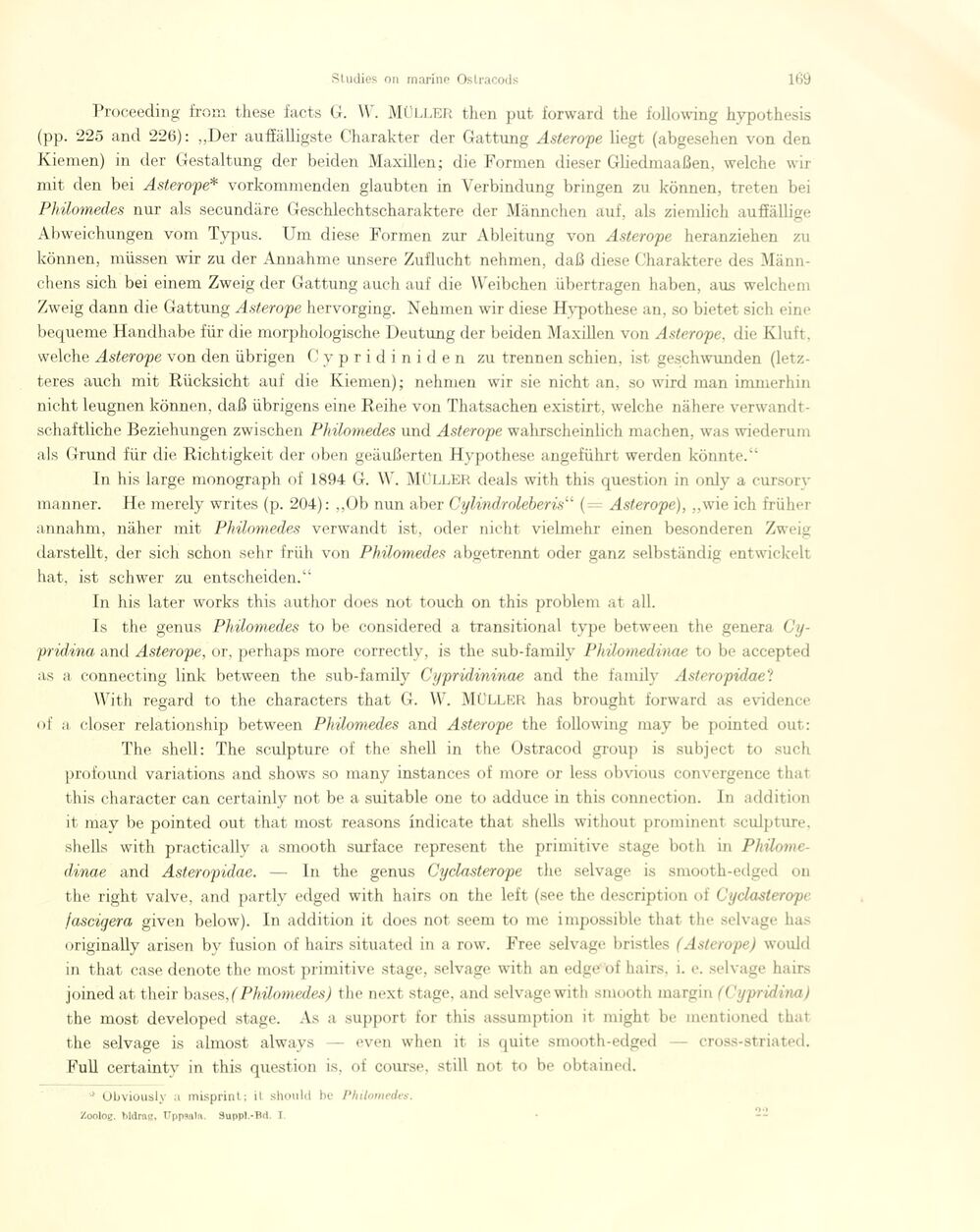
Full resolution (JPEG) - On this page / på denna sida - Sidor ...

<< prev. page << föreg. sida << >> nästa sida >> next page >>
Below is the raw OCR text
from the above scanned image.
Do you see an error? Proofread the page now!
Här nedan syns maskintolkade texten från faksimilbilden ovan.
Ser du något fel? Korrekturläs sidan nu!
This page has never been proofread. / Denna sida har aldrig korrekturlästs.
Proceeding from these facts U. W. MULLER then put forward the following hypothesis
(pp. 225 and 226) : „Der auffälligste Charakter der Gattung Asterope liegt (abgesehen von den
Kiemen) in der Gestaltung der beiden Maxillen; die Formen dieser Gliedmaaßen, welche wir
mit den bei Asterope* vorkommenden glaubten in Verbindung bringen zu können, treten bei
Philomedes nur als secundare Geschlechtscharaktere der Männchen auf, als ziemlich auffällige
Abweichungen vom Typus. Um diese Formen zur Ableitung von Asterope heranziehen zu
können, müssen wir zu der Annahme unsere Zuflucht nehmen, daß diese Charaktere des
Männchens sich bei einem Zweig der Gattung auch auf die Weibchen übertragen haben, aus welchem
Zweig dann die Gattung Asterope hervorging. Nehmen wir diese Hypothese an, so bietet sich ein*’
bequeme Handhabe für die morphologische Deutung der beiden Maxillen von Asterope. die Kluft,
welche Asterope von den übrigen Cypridiniden zu trennen schien, ist geschwunden
(letzteres auch mit Rücksicht auf die Kiemen); nehmen wir sie nicht an, so wird man immerhin
nicht leugnen können, daß übrigens eine Reihe von Thatsachen existirt, welche nähere
verwandtschaftliche Beziehungen zwischen Philomedes und Asterope wahrscheinlich machen, was wiederum
als Grund für die Richtigkeit der oben geäußerten Hypothese angeführt werden könnte.“
In his large monograph of 1894 G. W. MÜLLER deals with this question in only a cursorv
manner. He merely writes (p. 204): „Ob nun aber Cy lindr oleberis ‘ ‘ (= Asterope), „wie ich früher
annahm, näher mit Philomedes verwandt ist, oder nicht vielmehr einen besonderen Zweig
darstellt, der sich schon sehr früh von Philomedes abgetrennt oder ganz selbständig entwickelt
hat, ist schwer zu entscheiden.“
In his later works this author does not touch on this problem at all.
Is the genus Philomedes to be considered a transitional type between the genera
Cy-pridina and Asterope, or, perhaps more eorrectly, is the sub-family Philomedinae to be accepted
as a connecting link between the sub-family Cypridininae and the family Asteropidae?
With regard to the characters that G. W. MÜLLER has brought forward as evidence
of a doser relationship between Philomedes and Asterope the following may be pointed out:
The shell: The sculpture of the shell in the Ostracod group is subject to such
profound variations and shows so many instances of more or less obvious convergence that
this character can certainly not be a suitable one to adduce in this connection. In addition
it may be pointed out that most reasons indicate that shells without prominent sculpture,
shells with practically a smooth surface represent the primitive stage botli in
Philomedinae and Asteropidae. — ln the genus Cyclasterope the selvage is smooth-edged on
the right valve, and partly edged with hairs on the left (see the description of Cycleisleropi
fascigera given below). In addition it does not seem to me impossible that the selvage lias
originally arisen by fusion of hairs situated in a row. Free selvage bristles (Asterope) would
in that case denote the most primitive stage, selvage with an edge of hairs. i. e. selvage hairs
joined at their bases,(Philomedes) the next stage, and selvage wit h smooth margin (Cypridina)
the most developed stage. As a support for this assumption it might be mentioned that
the selvage is almost always — even when it is quite smooth-edged — cross-striated.
Füll certainty in this question is, of course, still not to be obtained.
* Ubviously a misprint; il should be Philomedes.
Zoolog, bidrag, Uppsala. Suppl.-Bd. I
<< prev. page << föreg. sida << >> nästa sida >> next page >>